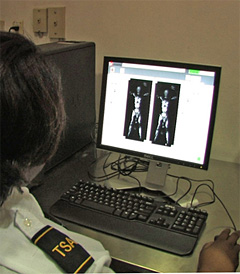Airport Scanners See Through Clothes
 Ina Paiva Cordle - MiamiHerald.com Ina Paiva Cordle - MiamiHerald.com
go to original


| | A TSA screener observes an image from a new whole-body scanner installed at Miami International Airport. The device uses radio waves to see objects through clothing. (Battle Vaughn/Miami Herald) | | |
Whole body imaging is now being used at Miami International Airport, raising the issues of travelers' security vs. privacy.

Travelers, be aware: Your full-blown image - private parts and all - could soon be visible to a security officer, on-screen, at an airport near you.

Miami International Airport is one of a dozen airports nationwide that have begun pilot-testing whole-body imaging machines, which reveal weapons and explosives concealed under layers of clothing.

"It allows us to detect threat objects that are not metallic and that cannot be detected by metal detectors, and items that are sometimes missed even in a physical pat-down, in a nonintrusive manner," said Mark Hatfield, federal security director for the Transportation Security Administration at MIA.

As passengers step inside the machine, they extend their arms and legs for several seconds, as millimeter wave technology creates an image. About 25 feet away, in a covered booth, a security officer in radio contact, views the ghostly silhouette - with the face blurred - on a screen. The officer determines if a concealed weapon, such as a ceramic knife, or explosive detonation cord, exists, Hatfield said.

"The image projected is more humanoid than human," he said. "What's important is providing a clear view of a threat object. And the person going through the machine will never see the operator."

'RANDOM SELECTION'

So far, the technology has been used for five days at two MIA checkpoints, at Concourses G and J, replacing the machines that emitted puffs of air. At least two more body-imaging machines will be deployed in the next few months, one at J and one at an interim checkpoint at C/D, Hatfield said. Each machine costs $170,000. To date, no explosives have been detected, he said.

At least for now, the TSA is using "continuous, random selection" to choose passengers for the machines, and it is optional. Travelers who decline will be physically patted down. All passengers must still go through metal detectors.

"For our travelers, through this airport, this machine adds even an additional layer of security," said Miami-Dade Aviation spokesman Marc Henderson.

'STRIP SEARCH'

Full body imaging technology has been in the works for at least five years, as the government grappled with issues of privacy and civil liberties, Hatfield said.

"It is tantamount to, essentially an electronic strip search, and that is our concern," said Howard Simon, executive director of the American Civil Liberties Union of Florida. "The most intrusive technology that intrudes upon personal privacy should not be the first line of our security."

Hatfield said that the TSA has mitigated those concerns by having the security officer located in a remote booth, where he or she never sees the passenger. Furthermore, the passenger's face is blurred on the screen. And the image is permanently deleted immediately after viewing and cannot be stored, printed or transmitted, Hatfield said.

'NAIVE'

Still, privacy concerns remain.

"It is naive to think that the use of this technology will be restricted to airports," Simon said. "The problem here is that we are shredding what little remains of personal privacy in America without much careful thought."

Unlike the puffer machines, which blast a person with air, then vacuum the particles and scan them for traces of explosives, the body-imaging machines use millimeter waves. A passenger steps into the machine and remains still for a few seconds, while the technology creates a three-dimensional image of the passenger from two antennas that simultaneously rotate around the body.

LOW LEVEL OF ENERGY

Millimeter waves use electromagnetic waves to generate an image based on the energy reflected from the body, creating a robotic image. The energy emitted is 10,000 times less than that of a cellphone, the TSA said.

Miami is one of 21 airports nationwide receiving the new technology.

The whole body imaging machines are already in use in Los Angeles, New York's JFK, Baltimore-Washington, Denver, Albuquerque, Ronald Reagan Washington, Detroit, Dallas-Fort Worth and Phoenix Sky-Harbor, Washington Dulles and Las Vegas airports.

Other airports that will get the new machines in the coming months include Chicago O'Hare, Atlanta, Newark, Boston, Indianapolis, New York LaGuardia, Tampa, San Juan and San Francisco, the TSA said. There are no current plans to place the machines at Fort Lauderdale-Hollywood.

icordle(at)MiamiHerald.com |



